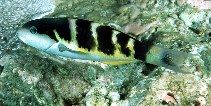| Family: |
Labridae (Wrasses), subfamily: Corinae |
| Max. size: |
20 cm TL (male/unsexed) |
| Environment: |
reef-associated; marine; depth range 1 - 15 m, non-migratory |
| Distribution: |
Indo-West Pacific: Maldives to Fiji, north to southern Japan, south to Lord Howe Island. |
| Diagnosis: |
Dorsal spines (total): 8-8; Dorsal soft rays (total): 13-13; Anal spines: 3-3; Anal soft rays: 11-11. Color pattern remains similar throughout life. Large juveniles and females are mostly black with a single white band and white area below the head to the anus. Males retain the white central band but is more yellow, and develops a second narrow band halfway towards the head (Ref. 48636). Initial phase white with 3 black bars, the first on upper half of head and anterior body containing a yellow streak at edge of opercle, the second across dorsal fin and ventrally to anus, the third covering most of body and posterior portions of dorsal and anal fins. Terminal male with yellow between black bars. Pectoral fins bluish (Ref 9823). |
| Biology: |
Occurs in groups (Ref. 90102) in exposed crests of seaward and lagoon reefs, usually rock-based. Minimum depth reported from Ref. 27115. Replaced by T. nigrofascatum in Papua New Guinea (Ref. 90102). |
| IUCN Red List Status: |
Least Concern (LC); Date assessed: 05 March 2009 Ref. (130435)
|
| Threat to humans: |
harmless |
Source and more info: www.fishbase.org. For personal, classroom, and other internal use only. Not for publication.

